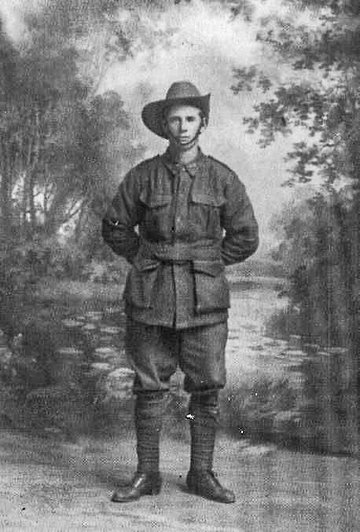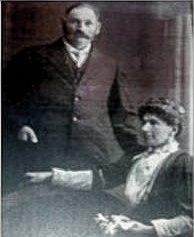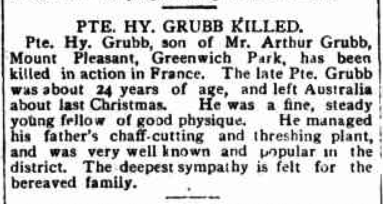Henry Robert GRUBB
Eyes blue, Hair fair, Complexion fair
A story of Goulburn farming families
In preparing this story, we are most grateful for the continuing input and research by family members, Lynne Tocher and Edith Medway.
This is, in part, the story of two close families and two close mates buried in France, Harry (Henry Robert) Grubb 1895-1916 from Towrang east of Goulburn and his cousin Lindsay Bertram Murray 1892-1916 from Breadalbane west of Goulburn. The young men were the sons of two sisters, Marian May and Arabella Peters who were closely connected to many families in the Goulburn area.
Marian and Arabella were very close, having lost their mother, Anna, when they were just 14 and 16 years of age respectively. Anna had died in 1883 while giving birth to twin boys, Andrew and Septimus, who, in addition to four other younger siblings, were then left in the care of the two teenaged sisters. Older brother Henry, at 18 would have worked on the farm. The extended connected families and neighbours would have been of great support at this time.
Marian married Arthur Grubb in 1894 while Arabella married Tom Murray in 1888. Harry Grubb was the eldest of 8 children while Lindsay Murray was the third child of 10.
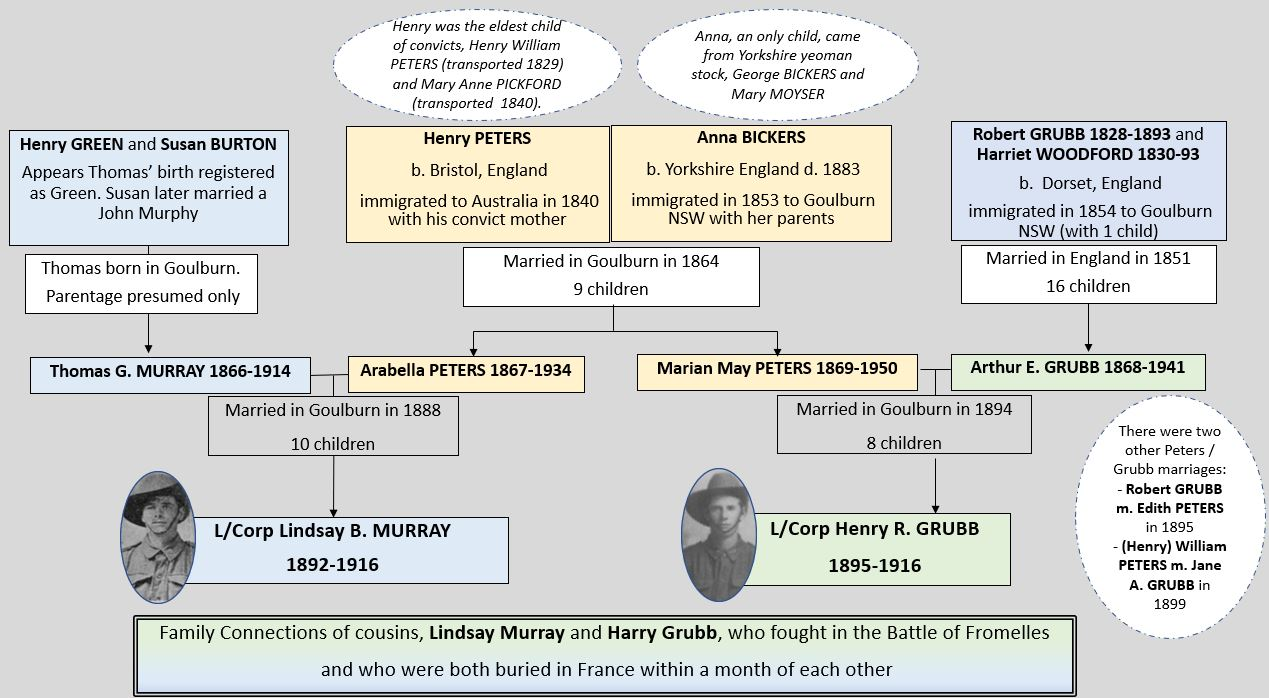
Tragically, for the families and the broader Goulburn communities, Marian and Arabella lost their sons at much the same time; both were buried far away on the battlefields of France. Both sons fought in the Battle of Fromelles.
The Grubb Family
The eldest son of Marian (nee Peters) and Arthur Grubb, Henry Robert Peters, was born on 28 April 1895. Seven more children were to follow making a family of three sons and five daughters – Henry, Marian, Sarah, Ellen, Florence, Bertha, Arthur and Oswald. It seems that only Florence, Arthur and Oswald were known by their given names. Henry was known as Harry, Marian was May, Sarah was Allie, Ellen was Nell and Bertha was Birdie.
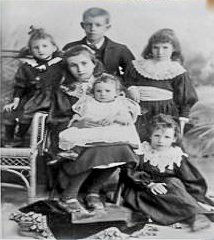
Arthur Grubb was a farmer, originally at Mt Pleasant on Middle Arm Road near Goulburn. Sometime after his marriage to Marian Peters in 1894, they acquired a property at Greenwich Park (north-east of Goulburn) known as “The Meadows” where, as Marian’s obituary describes it:
"they pioneered a home from almost virgin bushland."
Young Harry attended school at Greenwich Park and, after finishing school, worked on the family farm managing his father’s chaff-cutting and threshing plant. He was also a member of the Towrang Rifle Club from the age of 17.
Enlistment
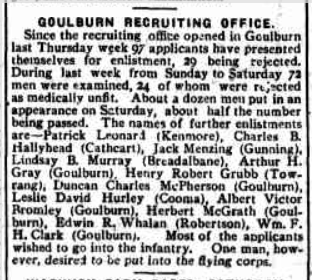
Aged 20, Harry Grubb enlisted on 30th July 1915 at the Goulburn recruiting office together with his older cousin, Lindsay (Lin) Murray, from Breadalbane. The news article above indicates that one of the recruits was keen to join the flying corps. That recruit may have been young Harry as, in a letter home to his parents a year later (dated 4 July 1916), Harry said :
“I have just written out an application to go into the Royal Flying Corps. Volunteers were called for this evening, so I may have a chance this time.”
Sadly, it was not to be.
The two cousins were assigned to different units – Lin to the 4th Battalion and Harry to the 20th Battalion (6th reinforcements) – and Lin was the first to embark for Egypt leaving on 13 October. Harry left 3 weeks later on 2 November 1915 on board HMAT A14 Euripides.
Prior to his departure, Harry had leave at home and was the guest of honour at a farewell function as “the first from the Greenwich Park district to offer his services to the Empire”.
He was presented with a sterling silver wristlet watch and also - from the pupils of the Greenwich Park School - a sheepskin vest to deal with the cold in Europe. Harry responded with thanks and added that:
"he hoped that he would some day return to his many friends at Greenwich Park and the surrounding districts."
Egypt
Arriving in Egypt in mid-December, the 6th reinforcements, 20th Battalion encamped at Tel-El-Kebir awaiting the arrival of the main body of the 20th from the evacuation of Gallipoli. Harry and his fellow recruits would have begun desert training in the interim. The 20th arrived on 10 January 1916 and training began in earnest.
On 16 February, Harry was transferred to the newly formed 56th Battalion. This was a result of the reorganization of the AIF post-Gallipoli which aimed to integrate raw recruits like Harry Grubb with the more seasoned troops from Gallipoli. Three weeks later, Harry was promoted to Lance Corporal on 7 March 1916.
Little detail is known of Harry’s time in Egypt, but his AIF file shows that he was hospitalised for a week in April with a fever, recorded as PUO (pyrexia of unknown origin). This period included his 21st birthday on 28 April – no way to celebrate. He returned to his unit on 30 April.
Unit diary files indicate that training focused on fitness – using desert marches, swimming in Suez Canal, sports carnivals, etc. - discipline and rifle skills. Improvements were evident despite also coping with extreme heat, desert conditions, limited supplies of kit and illnesses.
Harry sent a letter dated 4 June to his parents just before leaving Egypt commenting on the hot climate and indicating that he “will not be sorry to get away from Egypt and from what I can hear we are going soon”. As part of those preparations to leave, Harry warned his parents not to send any clothing but rather to send things they can smoke or eat. He wrote:
“We are not allowed to have anything except what we can carry on our back. We had to empty our kit bags out the other day and throw everything away that was private. It did seem a shame to me to see all the good clothing and things that were thrown out – sheep-skin vests and socks galore. We are only allowed to carry two pairs of socks.”
That sheepskin vest given to Harry by the pupils of his former school was thrown out in Egypt and never made it to Europe to protect him from the cold. And the rumours were true as the 56th Battalion left Egypt on 19 June 1916 and arrived in Marseille ten days later.
France
Harry wrote home again soon after arriving in France to say that he was “in the best of health, and greatly relieved to be away from Egypt’s sandy deserts”. He found French girls good-looking and the country beautiful, likening the crops to the family property “The Meadows” at its best. He signed off asking that he be remembered to all old friends.
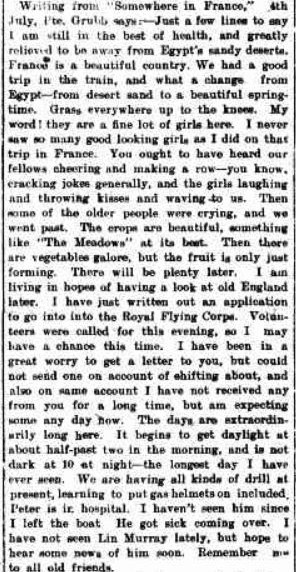
The train trip Harry describes in his letter home is the Battalion’s journey across France from the southern port of Marseille to the town of Thiennes near the northern border with Belgium – heading for the Western Front. It is likely that Harry’s letter was written while billeted in Thiennes.
The Battalion then moved on to Estaires closer to the trenches and training continued – gas helmet practice, Lewis gun training and route marches designed to harden up the men’s feet grown used to the softer sands of Egypt. On July 12, the 56th relieved the 46th Battalion at Wye Farm near Fleurbaix and were immediately subjected to shelling and artillery fire and experienced a gas alert. Casualties included two deaths and two wounded.
Battle of Fromelles
Relieved by British troops on 15 July, the 56th Battalion moved to new billets at Rue St Maur to prepare for a major attack on 17 July. The 56th were tasked with carrying stores into the frontline trenches in preparation for the attack. This was achieved with only one life lost. The attack, however, was postponed due to poor weather conditions so the Battalion continued to shift supplies up to the frontline.
For the newly appointed attack date of 19 July, the 56th were allocated as the reserve battalion for the Division. Following Brigade Operation Orders, the battalion was assembled by 6.30pm at Rue Quesnoy near Brigade headquarters. By 8pm, this reserve Battalion was called up to the front line and the unit’s war diary (AWM) describes the following hour as follows:
“..the enemy shelled very heavily. Notwithstanding the heavy shelling, the two companies reached the front line in very quick time, only suffering casualties to the number of about – 5 killed 30 wounded. Men remained in good spirits, showing no regard for enemy fire.”
The Battalion were also called on at 11pm to build a new communication trench to the captured German trenches during the night of 19-20 July. This was completed and duck-boarded before daylight allowing munitions to be brought up to the frontline and also saved numerous lives during the retirement of the Brigade on the morning of the 20th. The unit diary notes proudly “that it was the only trench in the Division, to be dug across “No man’s land” – and this was achieved whilst under fire.
It is difficult to know exactly Harry’s role during the Battle of Fromelles as we do not know which company he was attached to. We do know however that the men of the 56th were in the thick of things from 15 July in ensuring supplies were available when needed at the front line, moving up to the front line during the battle, and through to the washup after the retirement on the morning of the 20th (including retrieving the dead and wounded from no-man’s-land in the following days).
In Harry’s case, we have a rare gem in the form of his letters home shortly after the Battle of Fromelles. One was dated 27 July 1916 – probably from the Battalion’s base at Wye Farm near Fleurbaix – and aimed to reassure his parents as to his welfare (he also sent a cablegram via London on 5 August 1916 to assure his parents that he was well). He wrote in his letter:
“I have been in the firing line for about three weeks, and got my first baptism of shell fire. It shakes your nerves about all right. We had about ten hours of it without a break, and when they pulled up it was just like a calm after a storm.
One piece of shrapnel went through my tunic pocket. You would think a rat had been at it.
……….Well, you two must not worry, because I think – well, I am sure – God watched over me the other night and He will carry me safely through.”
And that, due to the censors, is all the detail Harry could give about the Battle of Fromelles.
Following the Battle
After the battle, the 56th Battalion remained in the Fleurbaix section near Elbow and Wye farms. They worked in the frontline and support trenches carrying out fatigue duties, patrols and relief duties and were regularly subject to artillery shelling, snipers and machine gun fire. There were a number of men wounded and killed during August.
In his letter dated August 3rd 1916, Harry reported that it “is a bit lively at night… and make us get into our dugouts in a hurry”. He also likened the machine gunfire as “all the type-writing machines in creation” going at once and commented on the hazards of gigantic mosquitoes and plagues of rats and mice.

Lance Corporal Henry R. Grubb was killed in action on 31 August 1916. The unit’s war diary (AWM) for that day reported only one casualty:
“5.30am One man was shot (killed), by unaimed fire, while observing.”
Harry was buried in the cemetery near Battalion’s base at Wye Farm. The cemetery is now known as Y Farm Military Cemetery at Bois-Grenier (about 7 kilometres north of Fromelles) and Harry’s grave is in row F, grave 24.
Post-war correspondence indicates that Arthur and Marian’s first choice of inscription for their son’s gravestone was the biblical quote “Greater love hath no man than this, that he laid down his life for his friends”. This exceeded the 66-character limit so they chose instead the equally apt personal inscription – “A noble life nobly ended”
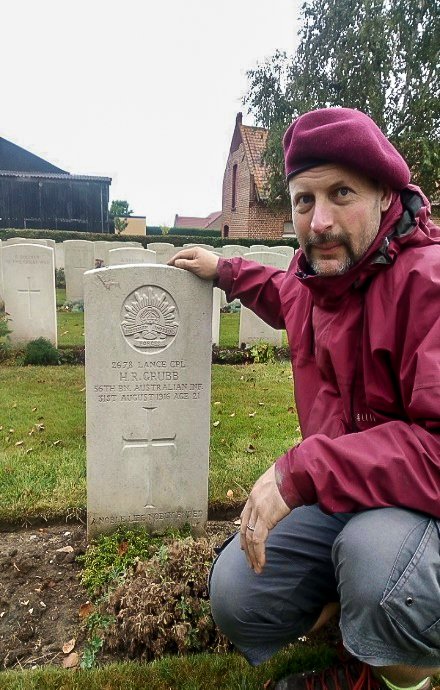
Family at home
It was late September before Arthur, as next of kin, was notified that his son had been killed in action. Harry’s letters written after Battle of Fromelles possibly arrived home after his death.
In the post-war roll of honour circular, his father noted with pride that Harry’s great-grandfather had been killed in the Battle of Waterloo and also that his cousin, Lindsay Murray, had also been killed in France a month before Harry.
His parents and siblings mourned his loss treasuring the medals and memorial plaque awarded after his death. In fact, his memorial plaque (known as a dead man’s penny) was embedded in his parents’ headstone in the Forest Cemetery off Middle Arm Road, Goulburn. As described in a Goulburn Post 2014 article:
“The ‘Memorial Plaque’ medal was the next best thing for parents, Arthur and Marian, knowing their son was buried a world away in France.”
In addition, Lance Corporal Henry Grubb is commemorated on:
- Mulwaree Remembrance Project, Mulwaree High School, Goulburn, NSW
- Panel 162, Australian War Memorial, Canberra, ACT
- Rocky Hill War Memorial Tower and First World War Honour Roll, Goulburn, NSW
- Marulan and District War Memorial, Marulan, NSW
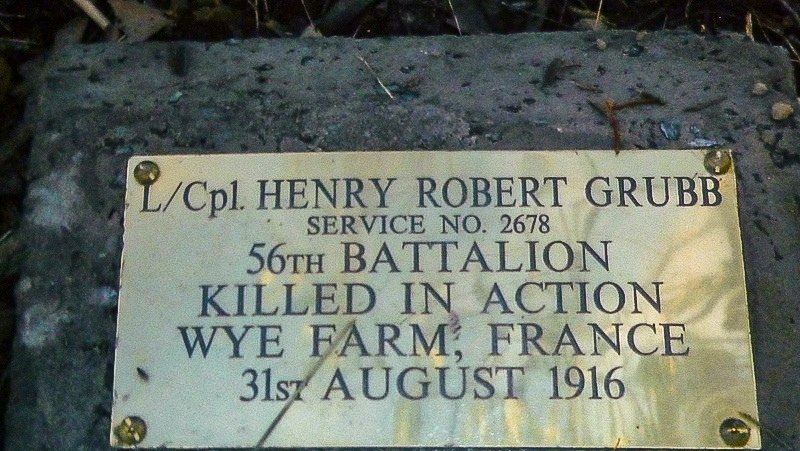
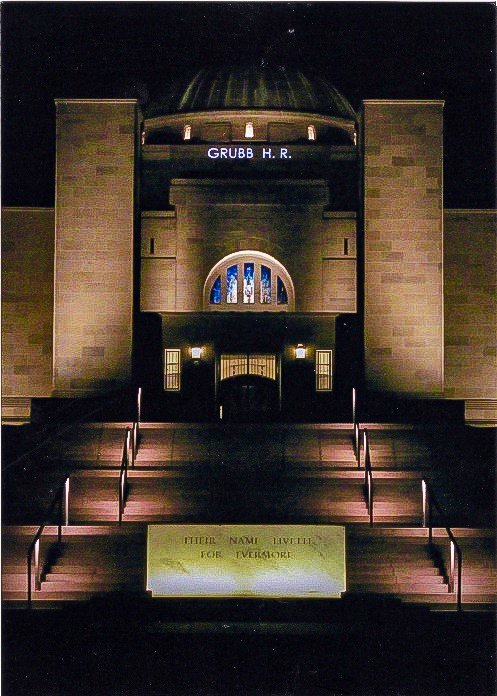
Family today still remember and honour Harry’s service with his nephew, Stephen, visiting his grave in France and many other family members researching and treasuring their photos and mementos of his life. His niece, daughter of Harry’s youngest sister, Edith Medway, has gone to considerable effort to ensure that Harry’s story is told and remembered. To this day, she keeps his photo on her office wall.
The Fromelles Association would love to hear from you

Contacts
(Contact: carla@fromelles.info or geoffrey@fromelles.info).
(Contact: army.uwc@defence.gov.au or phone 1800 019 090).
Donations
If you are able, please contribute to the upkeep of this resource.
(Contact: bill@fromelles.info ).
